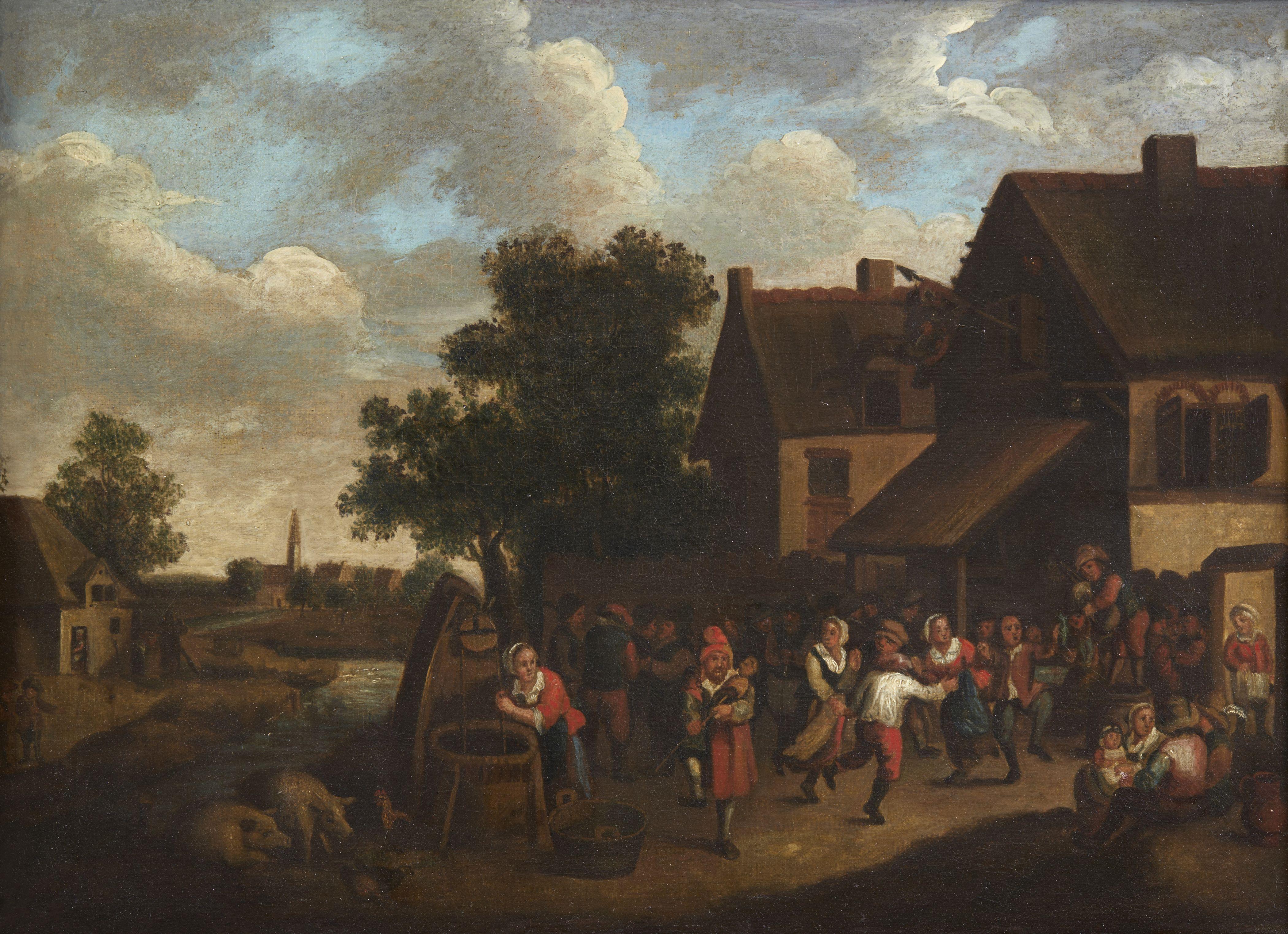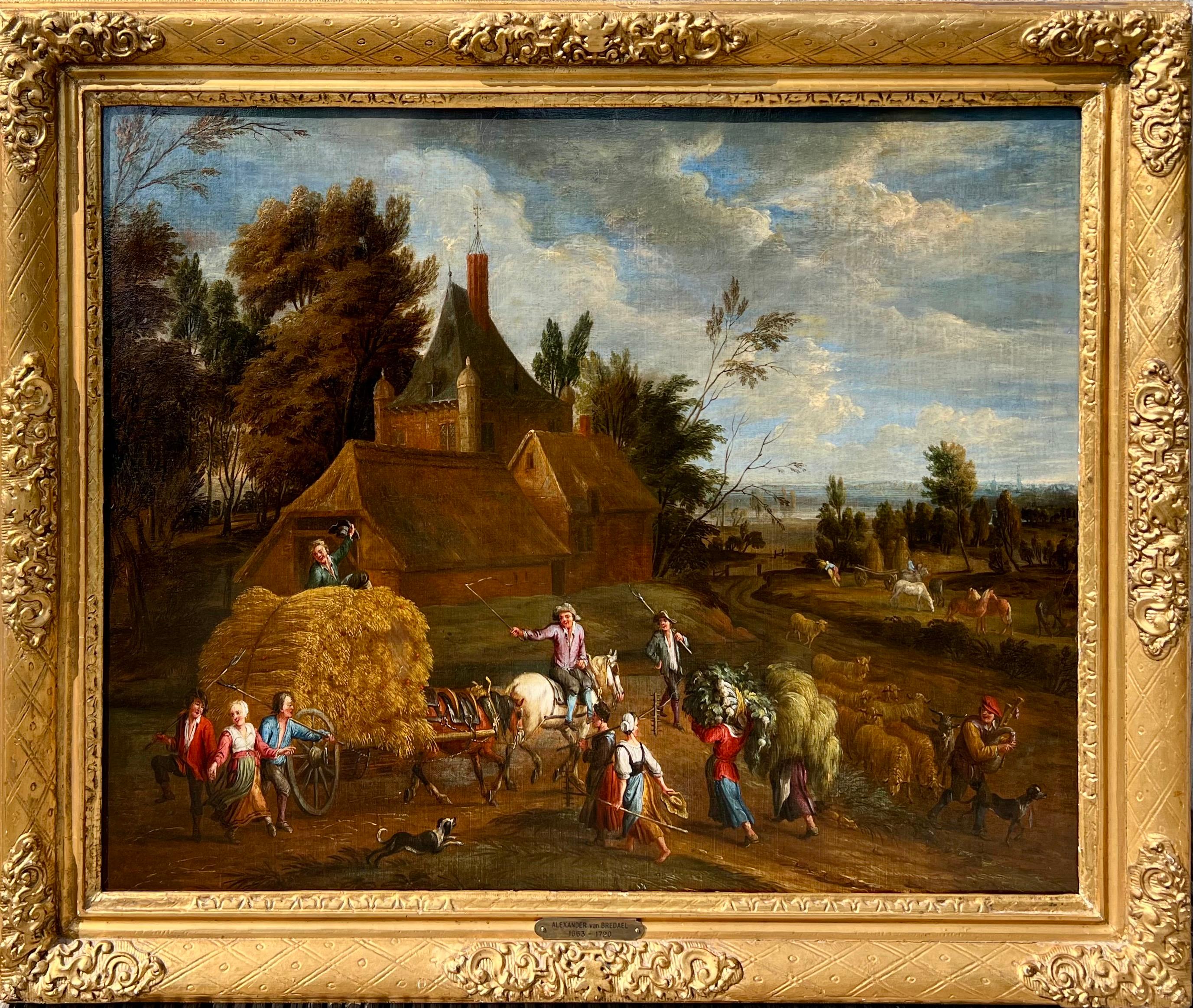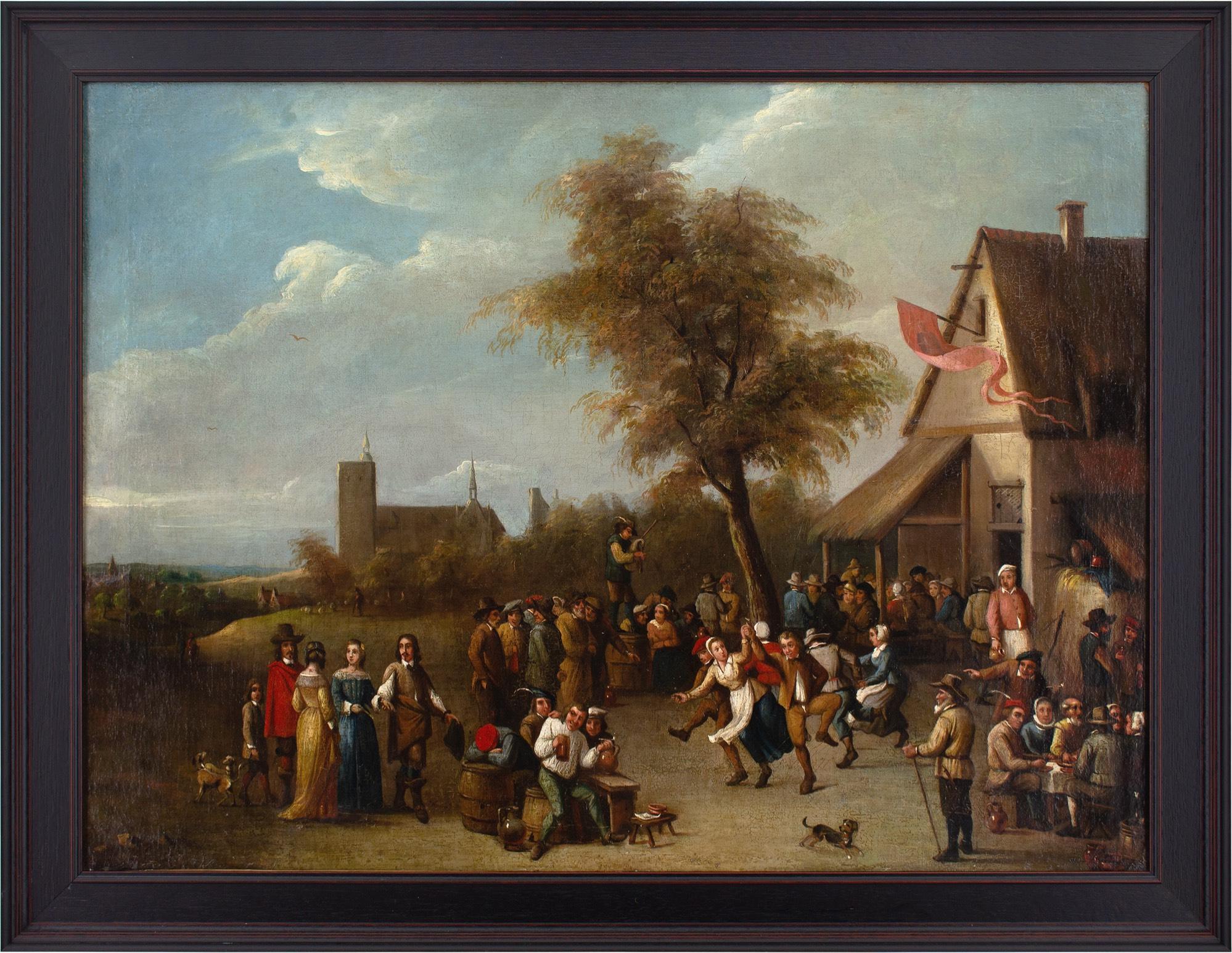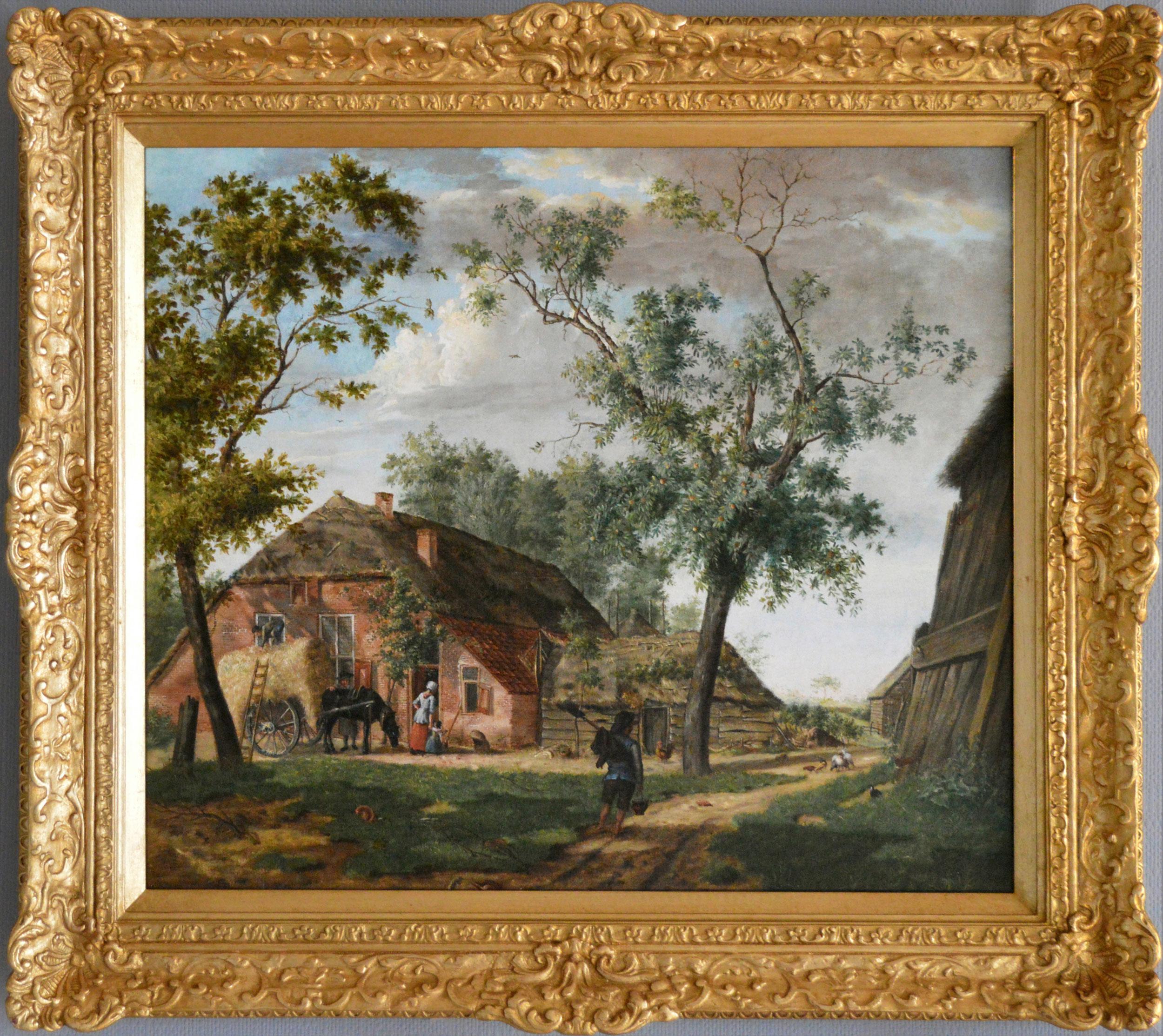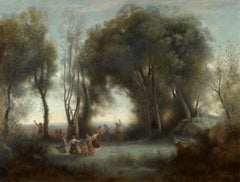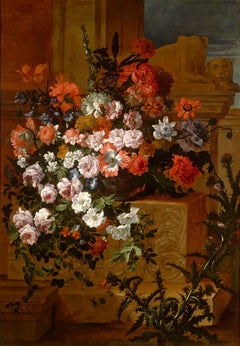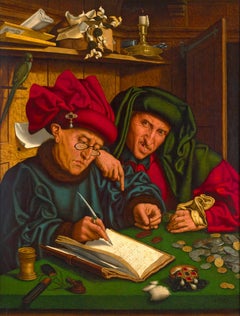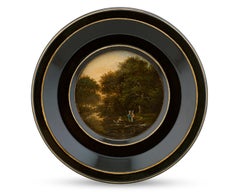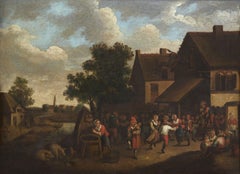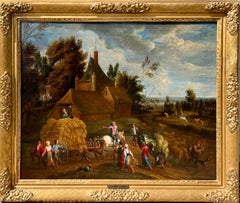Articles similaires à Scène de campagne paysanne par Jan Thomas van Kessel
Vous voulez plus d'images ou de vidéos ?
Demander au vendeur plus d'images ou de vidéos
1 sur 8
Jan Thomas van KesselScène de campagne paysanne par Jan Thomas van Kessel18th Century
18th Century
176 794,17 €
À propos de cet article
Jan Thomas van Kessel
1677-1741 Flemish
A Peasant Country Scene
Signed (lower left)
Oil on canvas
A quintessential example of Flemish genre painting, A Peasant Country Scene reflects a blend of the playfulness of subject and the technical acuity that defined the style of 18th-century Flemish painter Jan Thomas van Kessel. The artist invites viewers into a merry gathering of peasants that spills across the composition. Highlighted at its center is a couple in the midst of a lively dance, their direct gaze out at the viewer conveying their happiness, while also serving as an effective means to pull the viewer's eye into the festivities underway.
This gathering of merry revelers assumes a stage-like quality as they are separated visually from the far reaches of the composition by a fence that bisects the composition horizontally, underscoring the intimate feel of the foreground scene. Beyond this enclosure, a farmhouse looms over the scene and opens at right onto a sweeping landscape that carries the eye back into the distant horizon. Here, too, the eye is guided appropriately, as figures dot the path down the river toward the steeple of a church just visible along the horizon line. Overhead, a breathtakingly blue sky, dappled with billowy clouds and soaring birds, complements the festive scene.
Such genre paintings were incredibly popular during the 17th and 18th centuries, as they served as a reminder of the simple pleasures of pastoral life. Such scenes first emerged during the 16th century in the wake of the Reformation as artists sought new fields of painting in which to showcase their skill. Key figures such as David Teniers the Younger and the Brueghel family ensured the genre's success into the 17th century when they became highly fashionable. This enduring popularity thereby afforded later artists like van Kessel the opportunity to showcase their talents in conjuring such engaging vignettes.
Van Kessel clearly capitalized on that popularity, as he developed a following for his works that served as a visual escape from the realities of city life. Little is known of van Kessel's life, save for that he was born in Flanders in 1677 and studied both with the masters of Antwerp's Guild of Saint Luke, and even purportedly trained in Paris. Van Kessel then established his studio in his hometown of Antwerp just after the dawn of the 18th century. Aiding in van Kessel's rapid development as an artist was undoubtedly the fact that he descended from a long family line of painters who explored various subjects from botanical studies to portraits. It is arguably van Kessel's inviting scenes of peasants and pastoral life, as seen in this composition, however, that are the most engaging of his family's oeuvre and earned the artist acclaim for his work in Antwerp and beyond.
One point often noted in van Kessel's genre paintings are the references he makes to past masters like Teniers, and these connections are tangible in this painting. The layout of this composition, from the cluster of animated figures in the foreground contrasted against the serene expanse of nature in the distance, seem to be direct quotations of Teniers' work. This reinforces both the placement of this work within the 18th century – following Teniers' lifetime – and within van Kessel's body of work. The connection of this painting to Jan Thomas van Kessel's oeuvre is without dispute, however, as this painting benefits from the scrolling script of the artist's signature along the lower edge.
Only a handful of van Kessel's works, including those held by prestigious collections such as England's National Trust and the Museum Catharijneconvent in the Netherlands, have been fully documented. As a result, it is rare when such a well-preserved example of this 18th-century Flemish genre painting tradition emerges, and it is particularly exciting when such a find contributes to the emerging legacy of a little-understood artist of the era.
Canvas: 40 1/4" high x 54 1/4" wide
Frame: 52 3/4" high x 66 5/8" wide
- Créateur:Jan Thomas van Kessel (1677 - 1741, Flamand)
- Année de création:18th Century
- Dimensions:Hauteur : 133,99 cm (52,75 po)Largeur : 169,25 cm (66,63 po)Profondeur : 7,62 cm (3 po)
- Support:
- Mouvement et style:
- Période:
- État:
- Adresse de la galerie:New Orleans, LA
- Numéro de référence:Vendeur : 31-01981stDibs : LU18615260042
À propos du vendeur
5,0
Vendeur professionnel agréé
Chaque vendeur répond à des normes strictes en matière d'authenticité et de fiabilité
Établi en 1912
Vendeur 1stDibs depuis 2013
17 ventes sur 1stDibs
Temps de réponse habituel : 11 heures
- ExpéditionRecherche du devis...Expédition depuis : New Orleans, LA
- Politique des retours
Certaines parties de cette page ont été traduites automatiquement. 1stDibs ne garantit pas l'exactitude des traductions. L'anglais est la langue par défaut de ce site web.
Garantie d'authenticité
Bien qu'il soit peu probable que la situation se présente, dans le cas où vous rencontreriez un problème d'authenticité d'un article, contactez-nous dans un délai d'un an pour obtenir un remboursement intégral. DétailsGarantie de remboursement
Si votre article n'est pas conforme à la description, est endommagé pendant le transport ou ne vous est pas livré, contactez-nous sous 7 jours pour obtenir un remboursement intégral. DétailsAnnulation sous 24 heures
Vous disposez d'un délai de 24 heures pour annuler votre achat sans motif.Des vendeurs professionnels agréés
Nos vendeurs de renommée mondiale doivent respecter des normes strictes en matière de service et de qualité, afin de préserver l'intégrité de nos fiches produit.Garantie d'alignement des prix
Si vous constatez qu'un autre vendeur a mis en vente le même article à un prix inférieur sur un autre site, nous nous alignerons sur ce prix.Livraison en toute confiance à l'international
Notre réseau de transporteurs de premier ordre propose des options d'expédition spécialisées dans le monde entier, y compris des livraisons personnalisées.Plus d'articles de ce vendeur
Tout afficherDanse des nymphes
Par Paul Desire Trouillebert
Ce paysage lyrique intitulé Danse des Nymphes a été composé par le peintre français de Barbizon Paul Désiré Trouillebert. Scène joyeuse de ...
Catégorie
XIXe siècle, Académique, Peintures - Paysage
Matériaux
Toile, Huile
Nature morte aux fleurs de Jean-Baptiste Monnoyer
Par Jean-Baptiste Monnoyer
Jean-Baptiste Monnoyer
1636-1699 French
Still Life with Flowers on a Carved Stone Ledge
Oil on canvas
Impeccable detail and luminous color breathe life into this floral still lif...
Catégorie
17ème siècle, Maîtres anciens, Peintures - Nature morte
Matériaux
Toile, Huile
Les collectionneurs taxes attribués à Marinus van Reymerswaele
Marinus van Reymerswaele
c.1490 – c.1546 Néerlandais
Les percepteurs d'impôts
XVIe siècle
Huile sur panneau de bois
Marinus van Reymerswaele compte parmi les artistes les plus gra...
Catégorie
XVIe siècle, Peintures - Figuratif
Matériaux
Huile, Panneau en bois
Miniature allemande d'une sortie en bateau
Cette charmante peinture miniature allemande, réalisée à l'huile sur cuivre, représente une paisible sortie en bateau. Un couple richement vêtu se tient debout, tandis qu'un homme as...
Catégorie
XIXe siècle, Maîtres anciens, Peintures - Paysage
Matériaux
Cuivre
Portrait d'un homme par Frans Hals
Frans Hals
1582-1666 Néerlandais
Portrait d'un Gentleman
(peut-être Théodore Blevet)
Huile sur panneau
"Frans Hals est un coloriste parmi les coloristes... Frans Hals a dû avoir ...
Catégorie
17ème siècle, Maîtres anciens, Peintures - Portrait
Matériaux
Huile, Panneau
Prix sur demande
Jan Lutma, orfèvre par Rembrandt van Rijn
Par Rembrandt van Rijn
Rembrandt van Rijn
1606-1669 Néerlandais
Jan Lutma, L'orfèvre
Eau-forte, gravure et pointe sèche sur papier
Le deuxième état de cinq de NewNew
Signé et daté "Rembrandt / F. 1656" ...
Catégorie
17ème siècle, Maîtres anciens, Dessins et aquarelles - Figuratif
Matériaux
Papier, Gravure, Pointe sèche, Eau-forte
Suggestions
huile sur toile du 18e siècle Paysage flamand Scool Outdoor Peasant Brown Blue
Peinture à l'huile sur toile mesurant 45 x 55 cm sans cadre et 65 x 75 cm avec cadre, représentant une scène paysanne en plein air de l'école flamande de la fin du XVIIe et du début...
Catégorie
1690s, École flamande, Peintures - Paysage
Matériaux
Toile, Oil
Grand tableau flamand du 17e siècle représentant une fête des moissons - Paysage Campagne
Magnifique peinture de maître représentant une fête des moissons dans un village pittoresque du XVIIe siècle. Le tableau respire la paix et la tranquillité avec ses couleurs terreuse...
Catégorie
17ème siècle, Maîtres anciens, Peintures - Figuratif
Matériaux
Toile, Huile
Villageois dans un paysage - Flemish 17thC art figurative landscape oil painting
Cette fantastique peinture à l'huile flamande du XVIIe siècle est une œuvre de Thomas Van Apshoven. Elle a été peinte vers 1650 et représente un village avec des personnages à l'exté...
Catégorie
années 1650, Maîtres anciens, Peintures - Figuratif
Matériaux
Huile
6 630 € Prix de vente
20 % de remise
Cercle de David Teniers, paysage avec paysans par une auberge et une rivière, néerlandaise
Par David Teniers the Younger
Cercle de Teniers, paysans dans un paysage passant par une rivière et une auberge.
Catégorie
17ème siècle, Baroque, Peintures - Figuratif
Matériaux
Huile, Panneau
3 000 € Prix de vente
25 % de remise
David Teniers The Younger (Après), Country Celebration
Par David Teniers the Younger
Cette charmante peinture à l'huile du milieu du XVIIIe siècle représente un véritable groupe de fêtards en train de festoyer près d'une taverne. Il s'agit d'une œuvre de l'artiste fl...
Catégorie
années 1750, Peintures - Figuratif
Matériaux
Huile, Toile
Paysage à l'huile du début du 19e siècle représentant une ferme
Par Hermanus van Brussel
Hermanus van Brussel
Néerlandais, (1763-1815)
La cour de ferme
Huile sur toile
Taille de l'image : 18.25 pouces x 21.25 pouces
Dimensions, y compris le cadre : 24,5 pouces x 27,5 pou...
Catégorie
Début du XIXe siècle, Peintures - Paysage
Matériaux
Toile, Huile
